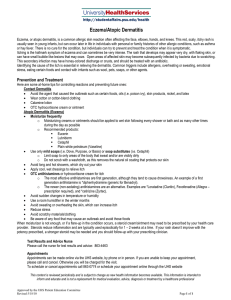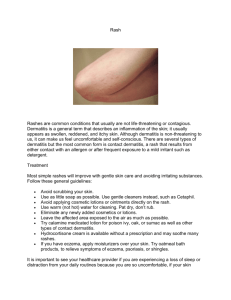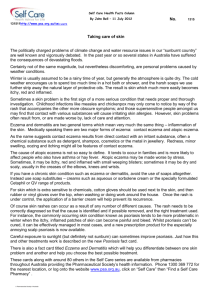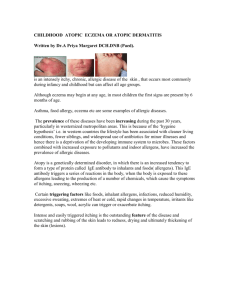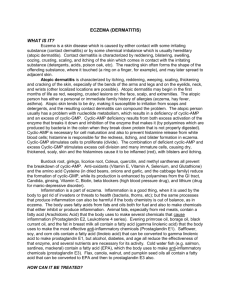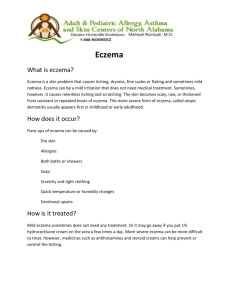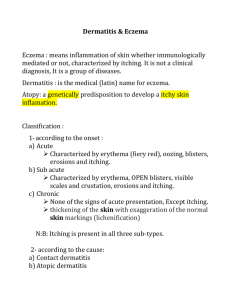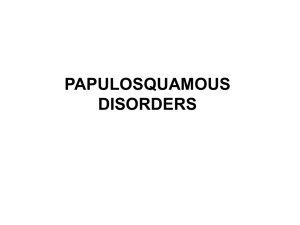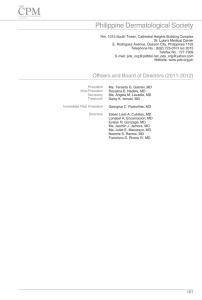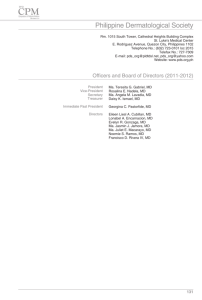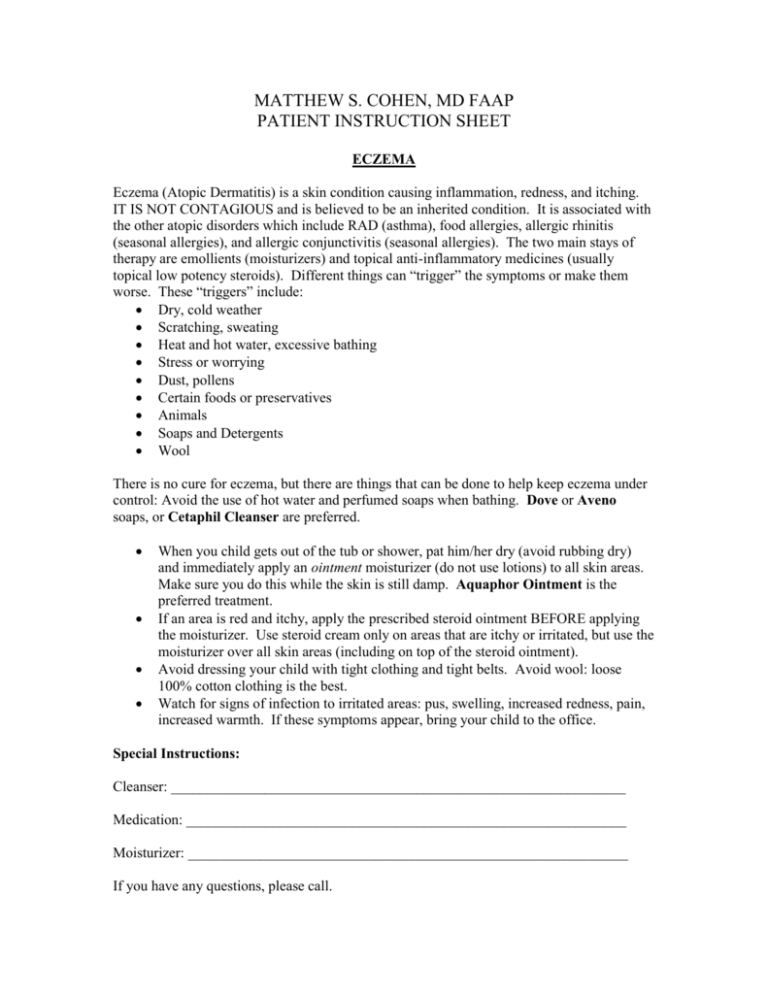
MATTHEW S. COHEN, MD FAAP
PATIENT INSTRUCTION SHEET
ECZEMA
Eczema (Atopic Dermatitis) is a skin condition causing inflammation, redness, and itching.
IT IS NOT CONTAGIOUS and is believed to be an inherited condition. It is associated with
the other atopic disorders which include RAD (asthma), food allergies, allergic rhinitis
(seasonal allergies), and allergic conjunctivitis (seasonal allergies). The two main stays of
therapy are emollients (moisturizers) and topical anti-inflammatory medicines (usually
topical low potency steroids). Different things can “trigger” the symptoms or make them
worse. These “triggers” include:
Dry, cold weather
Scratching, sweating
Heat and hot water, excessive bathing
Stress or worrying
Dust, pollens
Certain foods or preservatives
Animals
Soaps and Detergents
Wool
There is no cure for eczema, but there are things that can be done to help keep eczema under
control: Avoid the use of hot water and perfumed soaps when bathing. Dove or Aveno
soaps, or Cetaphil Cleanser are preferred.
When you child gets out of the tub or shower, pat him/her dry (avoid rubbing dry)
and immediately apply an ointment moisturizer (do not use lotions) to all skin areas.
Make sure you do this while the skin is still damp. Aquaphor Ointment is the
preferred treatment.
If an area is red and itchy, apply the prescribed steroid ointment BEFORE applying
the moisturizer. Use steroid cream only on areas that are itchy or irritated, but use the
moisturizer over all skin areas (including on top of the steroid ointment).
Avoid dressing your child with tight clothing and tight belts. Avoid wool: loose
100% cotton clothing is the best.
Watch for signs of infection to irritated areas: pus, swelling, increased redness, pain,
increased warmth. If these symptoms appear, bring your child to the office.
Special Instructions:
Cleanser: _______________________________________________________________
Medication: _____________________________________________________________
Moisturizer: _____________________________________________________________
If you have any questions, please call.
Eczema and Dermatitis
Eczema is a general term used to describe a number of different skin conditions. It
usually appears as reddened skin that becomes moist and oozing, occasionally
resulting in small, fluid-filled bumps. When eczema becomes chronic (persists for a
long time), the skin tends to thicken, dry out and become scaly with coarse lines.
The two main types of eczema are atopic dermatitis and contact dermatitis.
Atopic dermatitis often occurs in infants and children who have allergies or a family
history of allergy or eczema, although the problem is not necessarily caused by an
allergy. Atopic dermatitis usually develops in three different phases. The first occurs
between 2 and 6 months of age, with itching, redness, and the appearance of small
bumps on the cheeks, forehead or scalp. This rash may then spread to the arms or
trunk. In many cases, the rash disappears or improves by 2 or 3 years of age.
The second phase of this skin problem occurs most often between the ages of 4 and
10 years, and is characterized by circular, slightly raised, itchy and scaly eruptions
on the face or trunk. These are less oozy and more scaly than the first phase of
atopic dermatitis, and the skin tends to appear somewhat thickened. The most
frequent locations for this rash are in the bends of the elbows, behind the knees, and
on the backs of the wrists and ankles. This type of eczema is very itchy, and the skin
generally tends to be very dry. The third phase, characterized by areas of itching
skin and a dry, scaly appearance, begins at about age 12 and occasionally continues
on into early adulthood.
Although there is no cure for atopic dermatitis, it generally can be controlled and
often will go away after several months or years. The most effective treatment is to
prevent the skin’s becoming dry and itchy. To do this:
Avoid frequent long, hot baths, which tend to dry the skin
Use skin moisturizers (e.g., creams or ointments) regularly and frequently to
decrease the dryness and itchiness
Avoid harsh or irritating clothing (wool or coarse-weave material)
If there is oozing or exceptional itching, use tepid (lukewarm) compresses on
the area, followed by the application of prescribed medications
Your pediatrician usually will suggest a medicated cream or ointment to control
inflammation and itching. These preparations often contain a form of cortisone and
should be used only under the direction of your doctor. In addition, other lotions or
bath oils might be prescribed. It’s important to continue to apply the medications for
as long as your pediatrician directs. Stopping too soon will cause the condition to
recur. In addition to the skin preparations, your child may need to take an
antihistamine by mouth to control the itching, and antibiotics if the skin becomes
infected.
The other type of eczema, contact dermatitis, is caused by contact with an irritating
substance. One form of this condition results from repeated contact with irritating
substances such as citrus juices, bubble baths, strong soaps, certain foods and
medicines, and woolen or rough-weave fabrics. In addition, one of the most common
irritants is the child’s own saliva. Contact dermatitis doesn’t itch as much as atopic
dermatitis and usually will clear when the irritant is no longer present.
Contact dermatitis can develop after skin contact with substances to which the child
is allergic. The most common of these are:
Certain flavorings or additives to toothpastes and mouthwashes (these cause
a rash around the mouth)
Glues and dyes used in the manufacture of shoes (they produce a reaction on
the tops of the toes and feet)
Dyes used in clothing (these cause rashes in areas where the clothing rubs or
where there is increased perspiration)
Nickel jewelry or snaps on jeans or pants
Plants, especially poison ivy, poison oak and poison sumac
Medications such as neomycin ointment
This rash usually appears within several hours after contact (one to three days with
poison ivy). It is somewhat itchy and may even have small blisters.
The treatment of allergic contact dermatitis is similar to the treatment of eczema,
although your pediatric dermatologist or allergist also will want to find the cause of
the rash by taking a careful history or by conducting a series of patch tests. These
tests are done by placing a small patch of a common irritant (allergen) against your
child’s skin. If the skin reacts with redness and itching, that substance should be
avoided.
If your child appears to have a rash that looks like eczema, your pediatrician will
need to examine it to make the correct diagnosis and prescribe the proper
treatment. In some cases, the pediatrician may arrange for a pediatric dermatologist
to examine your child.
Alert your pediatrician if any of the following occurs:
Your child’s rash is severe and is not responding to home treatment
There is any evidence of fever or infection (such as blisters, redness, yellow
crusts, pain or oozing of fluid)
The rash spreads or another rash develops
© COPYRIGHT AMERICAN ACADEMY OF PEDIATRICS, ALL RIGHTS RESERVED.
American Academy of Pediatrics, 141 Northwest Point Blvd., Elk Grove Village, IL, 60007, 847-434-4000

